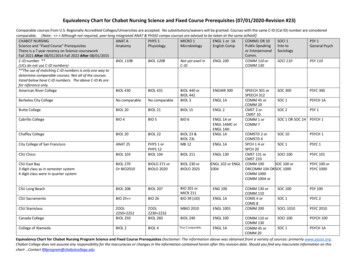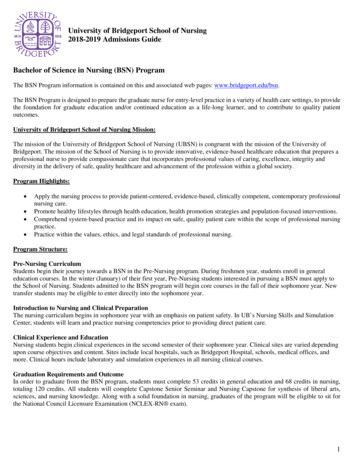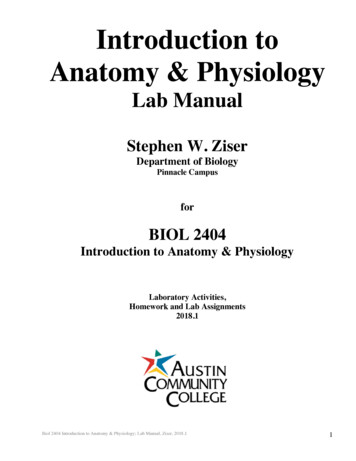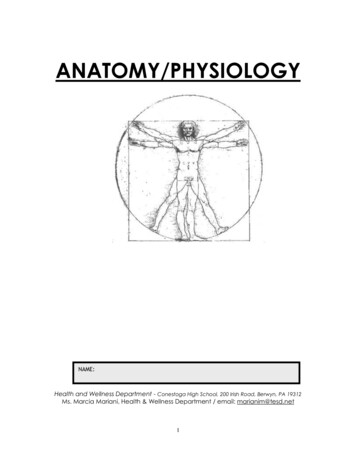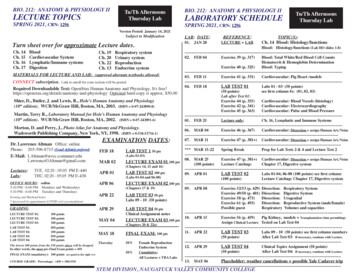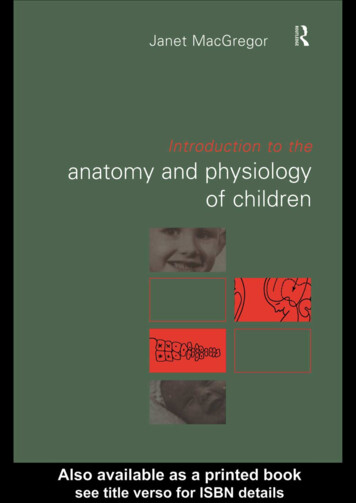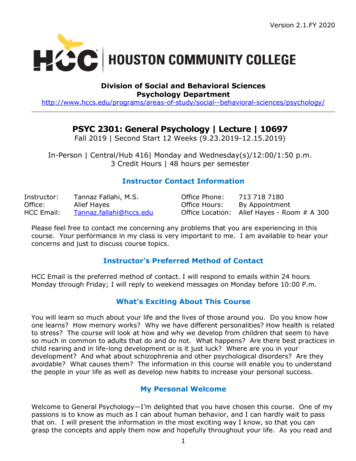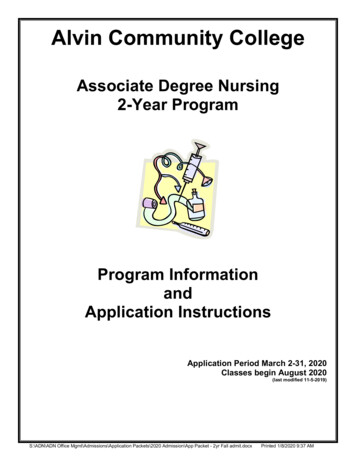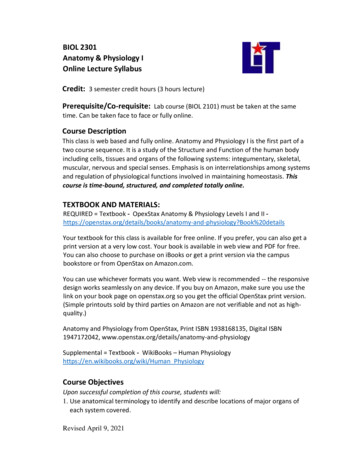
Transcription
BIOL 2301Anatomy & Physiology IOnline Lecture SyllabusCredit: 3 semester credit hours (3 hours lecture)Prerequisite/Co-requisite: Lab course (BIOL 2101) must be taken at the sametime. Can be taken face to face or fully online.Course DescriptionThis class is web based and fully online. Anatomy and Physiology I is the first part of atwo course sequence. It is a study of the Structure and Function of the human bodyincluding cells, tissues and organs of the following systems: integumentary, skeletal,muscular, nervous and special senses. Emphasis is on interrelationships among systemsand regulation of physiological functions involved in maintaining homeostasis. Thiscourse is time-bound, structured, and completed totally online.TEXTBOOK AND MATERIALS:REQUIRED Textbook - OpexStax Anatomy & Physiology Levels I and II siology?Book%20detailsYour textbook for this class is available for free online. If you prefer, you can also get aprint version at a very low cost. Your book is available in web view and PDF for free.You can also choose to purchase on iBooks or get a print version via the campusbookstore or from OpenStax on Amazon.com.You can use whichever formats you want. Web view is recommended -- the responsivedesign works seamlessly on any device. If you buy on Amazon, make sure you use thelink on your book page on openstax.org so you get the official OpenStax print version.(Simple printouts sold by third parties on Amazon are not verifiable and not as highquality.)Anatomy and Physiology from OpenStax, Print ISBN 1938168135, Digital ISBN1947172042, plemental Textbook - WikiBooks – Human Physiologyhttps://en.wikibooks.org/wiki/Human PhysiologyCourse ObjectivesUpon successful completion of this course, students will:1. Use anatomical terminology to identify and describe locations of major organs ofeach system covered.Revised April 9, 2021
BIOL 2301Lecture SyllabusAnatomy & Physiology I2. Explain interrelationships among molecular, cellular, tissue, and organ functions ineach system.3. Describe the interdependency and interactions of the systems.4. Explain contributions of organs and systems to the maintenance of homeostasis.5. Identify causes and effects of homeostatic imbalances.6. Describe modern technology and tools used to study anatomy and physiologyCourse Outline7.2.3.4.1. Human Body Intro Regional andDescriptive Termsa. Homeostasis that describe thehuman bodyb. Problem-solving scenarioc. Correct anatomical positionBody system and examplesPractice and diagramminglayersDermis and its componentsHypodermisb. Planes of the Body Demonstrationof planes using paperInterpretation of x-ray, CTscans and MRI imagesCellsa. Structures Organelles within ananimal cellFeatures of the plasmamembrane CytoskeletoncomponentsFunctionsa. Physiology of the organellesb. Physiology of the plasmamembranec. Physiology of the cytoskeletoncomponentsMitosisa. Stagesb. Special terminology5.6.7.8.c. Cancer – mitosis gone wrongTissuesa. Main types of epithelial tissue3 basic typesCharacteristics of eachb. Other tissues of the bodyPseduostratifiedStratified tissuesIntegumentary Systema. SkinLayers of the epidermis andspecialized cells within thoseAppendagesb. Hairc. NailsBones and Skeletal Systema. Basic Shapes of BonesHow to classify bonesPractice activityb. Bone Markings18 different bone markingsPractice activityc. Location on skeletonThe Skeletona. Bones of the axial skeletonSkullb. Ribs and vertebraePelvisc. Bones of the appendicularskeleton2
BIOL 2301Lecture SyllabusAnatomy & Physiology IArms, wrists and handsLegs, ankles and feetd. Jointse. Synovial jointsCharacteristicsSynovial fluidf. Other jointsHingePivotalSaddleBall-n-socket, etc.g. Movements of JointsClass demonstrationPractice activity9. Muscles and Muscle Tissuea. Introduction Physicsbehind musclemovement3 basic types of muscleb. Characteristics of MuscleTissue striations of skeletalmuscle specializedbranching of cardiac musclec. Related muscle terms10. Muscular Systema. Major muscles (anterior)b. Major muscles (posterior)11. Fundamentals of the NervousSystema. NeuronsAnatomy of the neuronPhysiology of the neuronb. Neuroglia and supportingcells ofthe nervousEinstein’s brain versus mosthumans; latest researchfindings 6 types of neurogliaand their locations andcharacteristicsc. Central Nervous SystemStructures of the BrainAll the parts of the brain, theirlocationsDistinguishing characteristicsFunctionsPhysiology Hormonesrelated to certainstructuresd. Peripheral Nervous SystemStructuresCranial nervesThoracic nervesLumbar nervesFunctionsPhysiologyReaction times/reflexGrade Scale90 –100 A80 – 89 B70 – 79 C60 – 69 D0 – 59 F3
BIOL 2301Lecture SyllabusAnatomy & Physiology ICourse Evaluation1. Mandatory Course Syllabus Quiz2. Discussion Participation3. Video Quizzes4. Chapter Quizzes (5)5. Exams Ch 1 – 8 (Midterm) Ch 9 – 16 (Final Exam)6. Mandatory Group Project7. Individual Project5%10%10%20%30%20%5%100%Course Requirements1. Student will participate in discussion boards for each of the chapters.2. Complete exams on the due dates. No late exams or assignments will be accepted.3. Student will complete a reading and writing assignment to be submitted online ondue date. No late papers accepted.4. Student will complete a current event with PowerPoint presentation (see video forinstructions). No late current events accepted.5. 3 quizzes total; with a quiz on Chap 1 Orientation to Body, Chap 6 Bones and Chap 9Muscles. To be completed on the due dates. No late quizzes accepted.Course Policies1. You must log into Blackboard and access this course a minimum of 3 times perweek.2. Cheating of any type will not be tolerated.3. Late assignments will not be accepted. Students will receive a zero for assignmentsnot completed.4. If you wish to drop this course, you must drop it administratively. If you do not dropyou will receive an F for the course.5. Internet usage- students are to use proper netiquette when participating in courseemail,assignment submissions and online ules.htmlTechnical RequirementsThe latest technical requirements, including hardware, compatible browsers, operatingsystems, software, JAVA, etc. can be found online at:4
BIOL 2301Lecture SyllabusAnatomy & Physiology Ihttps://help.blackboard.com/enus/Learn/9.1 2014 04/Student/015 Browser Support/015 Browser Support Policy A functional broadband internet connection, such as DSL,cable, or WiFi is necessary to maximize the use of the online technology and resources.Disabilities StatementThe Americans with Disabilities Act of 1992 and Section 504 of the Rehabilitation Act of1973 are federal anti-discrimination statutes that provide comprehensive civil rights forpersons with disabilities. Among other things, these statutes require that all students withdocumented disabilities be guaranteed a learning environment that provides forreasonable accommodations for their disabilities. If you believe you have a disabilityrequiring an accommodation, please contact the Special Populations Coordinator at (409)880-1737 or visit the office in Student Services, Cecil Beeson Building. visit the ecial/defaults.aspxStudent Code of Conduct StatementIt is the responsibility of all registered Lamar Institute of Technology students to access,read, understand and abide by all published policies, regulations, and procedures listed inthe LIT Catalog and Student Handbook. The LIT Catalog and Student Handbook may beaccessed at www.lit.edu or obtained in print upon request at the Student Services Office.StarfishLIT utilizes an early alert system called Starfish. Throughout the semester, you may receiveemails from Starfish regarding your course grades, attendance, or academic performance.Faculty members record student attendance, raise flags and kudos to express concern orgive praise, and you can make an appointment with faculty and staff all through theStarfish home page. You can also login to Blackboard or MyLIT and click on the Starfishlink to view academic alerts and detailed information. It is the responsibility of the studentto pay attention to these emails and information in Starfish and consider taking therecommended actions. Starfish is used to help you be a successful student at LIT.5
Physiology of the organelles b. Physiology of the plasma membrane c. Physiology of the cytoskeleton components 4. Mitosis a. Stages b. Special terminology c. Cancer – mitosis gone wrong Tissues a. Main types of epithelial tissue Characteristics of each Other tissues of the body Psedu
